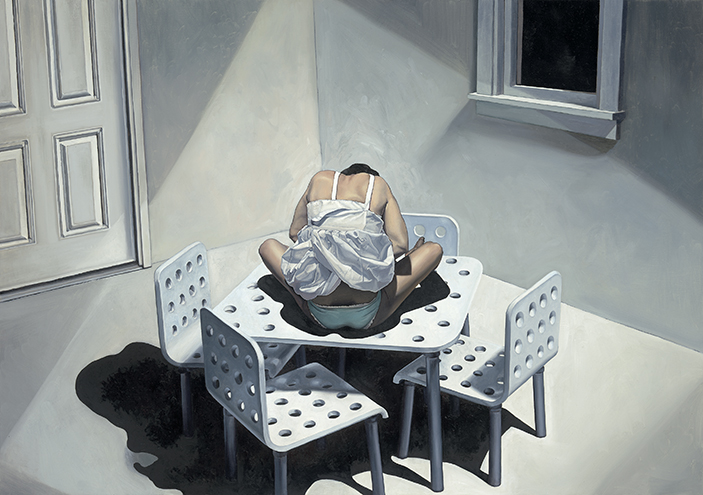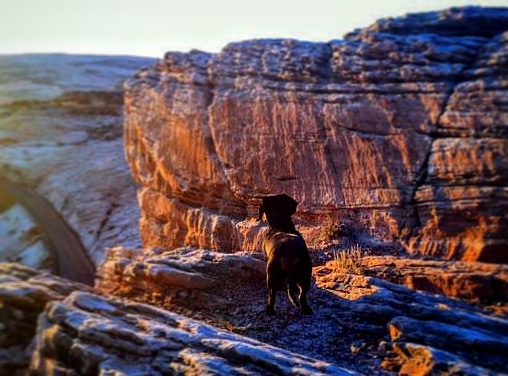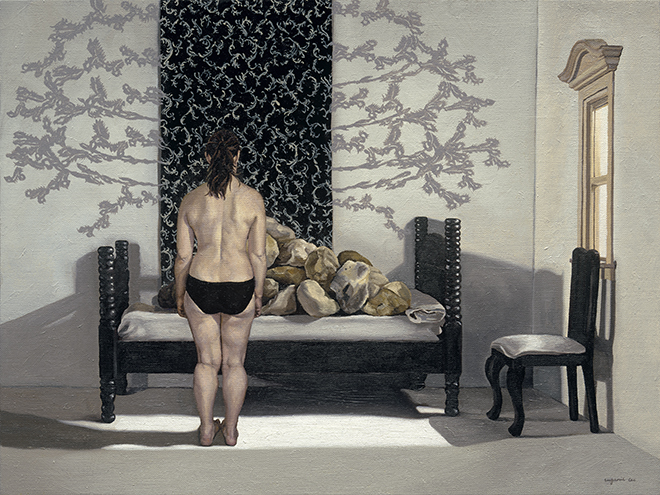I promised a post on the major turning points in my pain experience at the beginning of the year. Then life, and death, happened and it was put on hold. Those posts (there are two, reflecting two major turning points) will come soon, but first I wanted to share why I’ve been away, for those who may be wondering.
It’s been a rough 2018 for me, to be honest. There has been a lot of grief, a lot of sadness, of feeling adrift, of not being able to make sense of things. Our first waves of grief happened with the death by suicide of someone we loved dearly. It’s so hard to make sense of unexpected death to begin with, and even harder when it’s the suicide of someone full of life, love and laughter.
Just over two months later our beloved dog, Buster, died unexpectedly. If you’ve read many of my blogs, you’ve probably read about Buster. If you follow my Instagram account, you’ve surely seen pictures of him.
My best little buddy…and best therapy
Buster was my best friend. He was also my best therapy during the worst years of my pain, a source of joy, gratitude, and love, of daily laughter and a reminder to play and be goofy. He was our little adventure hound, always down for a road trip or camping and rode in planes, trains and automobiles, in buses and backpacks. Buster loved treats, getting cozy under the blankets, and going for walks. He always played hard after dinner, and sometimes he’d put himself to bed at night.
He continually reminded me of the important things in life: sleep, play, food, love, joy, gratitude. Mostly love. He had a big heart, in every sense. It was his enlarged heart that lead to his death in the end.
Buster got me outside when my life was so small and dark and pained. He brought me back out into the light, into the world. He understood me when no one else did. I never had to explain myself, he just got it, got me. He loved me unconditionally, even when I didn’t feel very lovable, perhaps especially when I didn’t feel very lovable.
He gave me courage and hope, and a bit of bravado, when I most desperately needed it.
Buster, my best little buddy
Ahhhh…this being human business…
So it has been a tough start to 2018. When I’m sad, I’m often silent. The same is true when I’m in pain. I don’t feel I have much to say, instead turning inward, reflecting, remembering, trying to make sense of things. I withdraw from the world a bit, my capacity to engage with people, places, experiences limited.
My bucket was overflowing with grief, no room for anything else for a bit. (I use this same metaphor with pain. Greg Lehman uses a cup metaphor). Only this time, there was no little buddy to comfort me, to get me to go outside, to remind me to play and laugh and be grateful for the day, the next meal, a cozy bed. No little buddy as a spigot at the bottom of the bucket to help me free up some space for something other than grief and sadness and pain.
Pain hurts
This pain is not the same as my hip pain, but it hurts nonetheless. It is still loss, still an inability to make sense of things, still anger and sadness, regret and wondering ‘what if…’, still blame and searching for answers.
There have been so many parallels between my experience of grief and my experience of chronic pain. So much that reminds me that these human experiences, uniquely ours yet also shared, are not compartmentalized in separate silos of our existence.
Grief, pain, depression, anxiety…they do not have separate, dedicated circuits or isolated brain territories. It is not a question of absence or presence, black or white, it is an overlapping spectrum of human experience made up of infinite components. Where we land on that spectrum at any given time differs between us and within us.
Where I am today is not where I will be tomorrow or five months from now, or where I was yesterday or five months ago.
Which got me thinking…
It’s time to stop pathologizing human emotions and the human experience. When I was in pain I felt grief for all that I lost, but it was never addressed as such.
Rather than speak of the primary losses, the emphasis in healthcare is on secondary gains. As though we are somehow winning when we experience ongoing, relentless pain, ongoing, relentless suffering.
I felt anger and fear and frustration. I ruminated about the past and what was and what could no longer be, I worried about a future that appeared hopeless and bleak, dark and despairing.
I’d lost my career and with it my identity, my financial security, my friends, my fire family, my future. I’d lost my hobbies and sports, my ability to sit and to socialize. My relationships became strained. I lost my place in the world.
How would you feel?
Grief is an untethering as well. The world doesn’t make sense in the way it once did.
It took me a long time to come to terms with my pain experience. I had to come to new information, to a new understanding of the biology of pain in order to change what the pain in my hip meant. To know that it didn’t mean damage, destruction, unchangeability. To accept all that had happened, all that had changed, knowing that it didn’t mean accepting that as my future, too.
Learning about pain biology wasn’t the whole story, of course. Biology doesn’t tell us the truth of our human experiences, it can only tell us the biological correlates of our human experiences.
Our pain, our grief, is not found in any randomized controlled trial or textbook.
I needed the humanities, too. I had to come to a new understanding of myself with pain, my unique experience, through things like classic literature and Buddhist philosophy. That’s what helped me change what the pain in my life meant. That’s what helped me shift my perspective, come to new understandings and find my place in the world again. Find myself again.
That helped end my suffering, even if it didn’t end my pain.
Rest, Rest, Rest by Eugenie Lee
I needed the science and the stories.
We all do.
I do now, again, as I work through grief and making sense of things yet again. As I make sense of this very human experience, uniquely mine yet shared by all of us.
A side note (rant?) on biology…
In thinking about how our experiences are both ours alone and shared amongst all of us, I got to thinking about biology, too.
Biology is the study of life, and when we look at the field of biology it covers everything from unicellular organisms to the biosphere. Ecology is a branch of biology that studies the interactions between living organisms and the interactions of living organisms with their environment. It recognizes that everything is connected.
Yet when we think of humans, we rarely speak of biology in terms of interactions with other humans and the environment. It seems that people think of ‘social factors’ as something external to the organism.
That is an error in thinking that we need to overcome.
If we can recognize how introducing wolves back into Yellowstone changes the ecosystem, changes biology (including bringing back beavers and Aspens), why do we not think of humans in the same, social way?
Will we ever get past the mind/body divide?
As Edward Bullmore wrote in The Inflamed Mind, I blame Descartes.
We are so entrenched in the body as machine, mind as (what? soul in the pineal gland? immaterial? thought bubble? the voice of God?), it seems a monumental feat for anyone to see mind/body as one organism, to recognize that our minds are embodied and our bodies enminded. That we are a unified organism living in a world of other living organisms in complex, interdependent ecosystems.
Biology is not just anatomy! It is also not just neuroscience, or immunology, or endocrinology. It’s all of it, including our interactions with other organisms and our environment. And including our thoughts, beliefs, memories, learning, expectations, behaviors – the purview of psychology – which is all underpinned by biology (if you have an argument that it’s not, please share).
<end rant>
Paincloud Convention (my life before pain on the screen)
The good amidst the grief
As with most things in life, the grief of this year has happened alongside good things, too.
I was at the San Diego Pain Summit when I learned of our loved one’s suicide. It was the night before I sat on the patient panel, a wonderful opportunity to share the lived experience perspective with the clinicians in attendance.
I don’t remember what I said but I hear the panel went over well. My co-panelists Erin Jackson and Mark Renard are amazing humans, I am so grateful to have sat alongside and hear their stories.
The panel was moderated by one of my favorite people in the world, Alison Sim. Alison has a new book out, Pain Heroes: Stories of Hope and Recovery, that I am so honored to be a part of. We need more stories of hope and recovery out there.
Another conference, another death
Buster died the night before my presentation at the Paincloud Convention in Oslo, Norway. It was devastating to be away, to not be there for his last moments, to not get to say goodbye and tell him how much I loved him and what a good dog he was. Not just a good dog, the best dog.
Our best friend, our young man, our best little buddy.
John was with me in Oslo. We were at a dinner for the speakers the night before the conference started when we found out. His pain and grief matched my own. It was the saddest, most difficult night to bear of our life of nearly 18 years together.
I gave my talk the next day. I’d wanted to honor my little buddy, to the honor the people living with pain I was there to speak for, to honor my own pain, old and new.
I didn’t make it to the last slides on my recovery (I went over time – always too many words!). It was a measure of self-protection I think. Buster played a huge role in my recovery. He was sprinkled throughout those slides in pictures.
I don’t think I could have held it together.
Our shared humanity
That presentation was the most important I’ve ever given, I think. I was at my most vulnerable in every sense.
At the Montana Pain Conference just a couple weeks before Paincloud, where I led breakout sessions on the patient experience both days and co-presented with my dear friend Dr. Chris Caldwell on teaching pain science into the patient narrative, Chris and I had a conversation where he said that it’s in sharing our weaknesses, not our strengths, that helps people the most. That it’s in our shared humanity that we can relate to one another and make an impact.
BYOH
In Amy Thompson’s talk at that conference she spoke of clinicians bringing their humanity to the table, of how we all need to bring our humanity to the table.
Amy’s a DPT who recently earned her MSc in Community Health. Images from her thesis, The Beauty in Pain: Storytelling & The Chronic Pain Experience, lined the back wall of the ballroom where the conference was held. It brought tears to my eyes. The portraits of people living with pain alongside their stories, in their own words, was profound.
It all stuck with me. I tried to bring my humanity to the table at Paincloud, to show our shared humanity through the the images of artwork created by people living with pain on the screen behind me as I told my story.
It is so incredibly hard to explain the unexplainable, so I wanted to show it, too.
If Only, by Eugenie Lee
My deepest gratitude goes to Eugenie Lee, Soula Mantalvanos, and PainExhibit.org, who let me share their pain and their visual stories. If you are not familiar with their work, please visit their pages and learn from them. If you truly want to understand pain, learn from the people who have lived it.
Other ways of knowing
One of the things I stressed at Paincloud was that we need other ways of knowing when it comes to truly understanding pain. As Howard Brody wrote in “My Story Is Broken; Can You Help Me Fix It?”, clinicians have a deeply rooted “need to know”and patient’s have an equally deep “need to be known.”
Our words are not always sufficient to know and be known.
Sometimes it helps to borrow words from others to help us express ourselves. Literature, song lyrics, poetry, metaphor, story, have much to offer in this regard. They can help us make sense of the unsensible, explain the unexplainable. And when there are no words, when words are inadequate, there is art. As the saying goes, a picture speaks a thousand words.
The humanities are too often neglected or, worse, denigrated when it comes to understanding pain and helping people make sense of their experiences. We need to change that. We do not make sense of our experiences in the lab, we make sense of them in the world and with others.
(For an interesting intersection of science and art, read “Frida Kahlo: Portrait of Chronic Pain” in the journal Physical Therapy.)
The world is messy. We are messy. We don’t come in neatly labeled boxes, we’re not readily categorized and filed away. Yet that’s how we try to conceptualize pain. It just doesn’t work that way.
We are not our brains. We are more than the sum of our parts.
Looking ahead
It is our shared humanity and our need for other ways of knowing that will inform my next two posts, which are reflections on two of the major turning points in my pain experience.
The first was a chat (an interview for grad school) with Lorimer Moseley, and his recommendation to me, and people living with chronic pain in general, to love and be loved.
The second was a chat (as a patient demo) with Peter O’Sullivan at the 2017 San Diego Pain Summit and his request of me to tell him my story.
These experiences shared a sense of being listened to, heard, and validated. I felt I was a human of worth and of equal standing, that my expertise about my pain was as valuable as their expertise about pain.
These are no small things. It is hard to convey the shame and unworthiness one often feels when living with pain for a long time. How devalued we can feel. For someone to take the time to listen, to talk with us rather than at us, reminds us we are worthy. It reminds us that we are human, not less than.
They brought their humanity to the table, and it made a profound difference in my life for which I’m eternally grateful.




Pingback: Our shared humanity, grief, why I’ve been away, and some musings on pain, biology, life… – MyCuppaJo.com | Neil Wise Physio
Pingback: Articles Of The Week July 14, 2018 « The Massage Therapist Development Centre